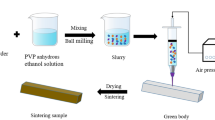Abstract
In this paper, the interfacial energy of various inorganic salts was calculated using the first principle. Finally, NaCl and Na2SO4 were determined as the core materials. A high-strength composite salt core was prepared by optimizing the distribution ratio of the salt core components. The microstructure of the salt core fracture was observed and characterized by SEM and EDS, and the strengthening mechanism of the salt core after the composite was analyzed. The results demonstrated that the strength of the composite salt core was significantly improved compared with the single salt. The bending strength of the salt core reached 24 MPa when the pouring temperature was 800 °C and the molar ratio of NaCl to Na2SO4 was 7:3. Cracks were first generated in the dendrite zone and extended to the surface of the salt core when the salt core was subjected to an external force. After compounding, the structure of the salt core strengthening zone was more complex, the crystal grains were significantly refined, and herringbone patterns appeared. The composite salt blocks are distributed in the strengthening zone and play a leading role in improving the strength of the salt core.










Similar content being viewed by others
References
B. Fuchs, H. Eibisch, Core viability simulation for salt core technology in High-Pressure die casting. Int. J. Metalcast. 7(3), 39–44 (2013). https://doi.org/10.1007/BF03355557
B. Fuchs, C. Koerner, Mesh resolution consideration for the viability prediction of lost salt cores in the high pressure die casting process. Progr. Comput. Fluid Dyn. Int. J. 14(1), 24–30 (2014). https://doi.org/10.1504/PCFD.2014.059197
X.Y. Liu, W.H. Liu, X.T. Wang et al., Composition optimization and strengthening mechanism of high-strength composite water-soluble salt core for foundry. Inter Metalcast (2021). https://doi.org/10.1007/s40962-021-00725-1
A.C. Robin, U.S. Patent No. 5803151, 8 Sept 1998
T. Sakoda, T. Suzuki. U.S. Patent No. 3963818, 15 June 1976
Meng S, Li H. Study and application of the Water-Soluble ceramic cores for the aluminum alloy casting. Special Cast Nonferr Alloys, 1989.
D.E. Grebe, M.P. Potratz, U.S. Patent No. 7013948B1, 21 April 2006
R. Moschini, U.S. Patent No. 6468297B2, 1 Oct 2002
Z. Xiao, L.T. Harper, A.R. Kennedy et al., A water-soluble core material for manufacturing hollow composite sections. Compos Struct 182, 380–390 (2017). https://doi.org/10.1016/j.compstruct.2017.09.058
A. Fortini, M. Merlin, G. Raminella, A comparative analysis on organic and inorganic core binders for a gravity diecasting Al alloy component. Inter Metalcast (2021). https://doi.org/10.1007/s40962-021-00628-1
Huang, et al. Study on the composition and properties of salt cores for zinc alloy die casting. Int J Metalcast Lead Transfer Res Technol Global Metalcast (2017).
Cihan Cantas,Bedri Baksan. Effects of composition on the physical properties of Water-Soluble salt cores. Int J Metalcast, 2020(prepublish):1–13
F. Liu, S. Tu, X. Gong et al., Comparative study on performance and microstructure of composite water-soluble salt core material for manufacturing hollow zinc alloy castings. Mater. Chem. Phys. 252, 123257 (2020). https://doi.org/10.1016/j.matchemphys.2020.123257
L. Chen, Y. Li, B. Xiao et al., Chemical bonding, thermodynamic stability and mechanical strength of Ni3Ti/α-Al2O3 interfaces by first-principles study. Scripta Mater. 190, 57–62 (2021). https://doi.org/10.1016/j.scriptamat.2020.08.021
C. Wang, C.Y. Wang, Ni/Ni3Al interface: a density functional theory study. Appl. Surf. Sci. 255(6), 3669–3675 (2009). https://doi.org/10.1016/j.apsusc.2008.10.017
P. John Perdew et al., Generalized gradient approximation made simple. Phys Rev Lett (1996). https://doi.org/10.1103/PhysRevLett.77.3865
B.G. Pfrommer, S.G. Louie et al., Relaxation of crystals with the Quasi-Newton method. J Comput Phys 131(1), 233–240 (1997). https://doi.org/10.1006/jcph.1996.5612
D.J. Siegel, L.G. Hector, J.B. Adams, Adhesion, atomic structure, and bonding at the Al(111)/α-Al2O3(0001) interface: A first principles study. MRS Proc 654(8), 5415 (2002). https://doi.org/10.1557/PROC-654-AA4.2.1
W. Choe, G.J. Miller, E.M. Levin, Crystal structure and magnetism of Gd2MgGe2. J Alloys Comp 329(1–2), 121–130 (2001). https://doi.org/10.1016/S0925-8388(01)01568-7
Q. Wang, P. Bai, Z. Zhao, First principle study of TiB2 (0001)/γ-Fe (111) interfacial strength and heterogeneous nucleation. Materials 14(6), 1573 (2021). https://doi.org/10.3390/ma14061573
Author information
Authors and Affiliations
Corresponding author
Additional information
Publisher's Note
Springer Nature remains neutral with regard to jurisdictional claims in published maps and institutional affiliations.
Rights and permissions
About this article
Cite this article
Wang, Xt., Liu, Wh., Liu, Xy. et al. First-Principles Calculation and Mechanical Properties of NaCl–Na2SO4 Composite Water-Soluble Salt Core. Inter Metalcast 17, 263–271 (2023). https://doi.org/10.1007/s40962-022-00769-x
Received:
Accepted:
Published:
Issue Date:
DOI: https://doi.org/10.1007/s40962-022-00769-x




